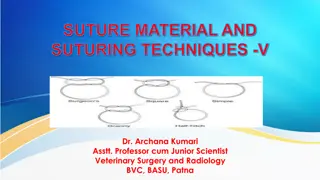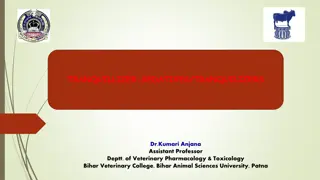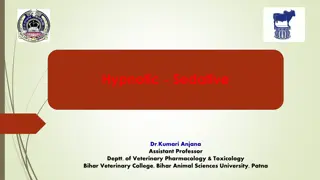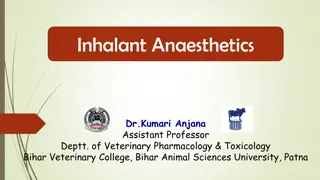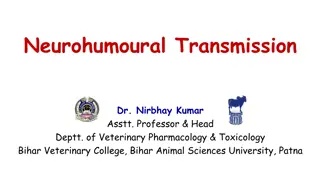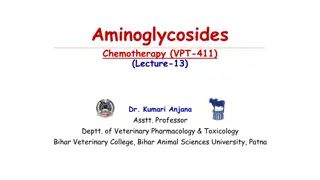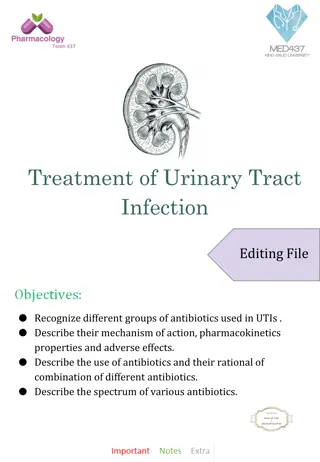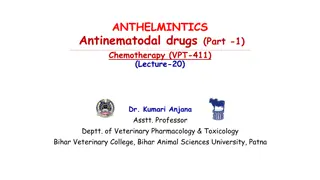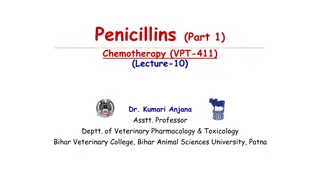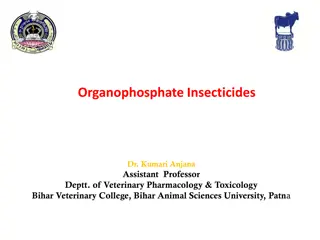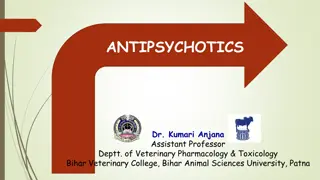Overview of Cephalosporins in Veterinary Pharmacology
Cephalosporins are a group of semisynthetic antibiotics derived from cephalosporin C obtained from a fungus. This chapter covers the introduction, chemistry, properties, solubility, classification, spectrum of activity, mechanism of action, applications, and side effects of cephalosporins. They offer a broad range of applications in veterinary pharmacology and are classified into different generations based on their composition and administration routes.
Download Presentation

Please find below an Image/Link to download the presentation.
The content on the website is provided AS IS for your information and personal use only. It may not be sold, licensed, or shared on other websites without obtaining consent from the author.If you encounter any issues during the download, it is possible that the publisher has removed the file from their server.
You are allowed to download the files provided on this website for personal or commercial use, subject to the condition that they are used lawfully. All files are the property of their respective owners.
The content on the website is provided AS IS for your information and personal use only. It may not be sold, licensed, or shared on other websites without obtaining consent from the author.
E N D
Presentation Transcript
Cephalosporins Chemotherapy (VPT-411) (Lecture-12) Dr. Kumari Anjana Asstt. Professor Deptt. of Veterinary Pharmacology & Toxicology Bihar Veterinary College, Bihar Animal Sciences University, Patna
Content of the chapter Cephalosporins Introduction, Source chemistry, classification spectrum of activity MOA Applications Side effects
Introduction, Source These are group of Semisynthetic antibiotics. Derived cephalospoium. from cephalosporin C obtained from a fungus Initially 3 natural cephalosporins viz. cephalosporin P,N,C were isolated from fungus Cephalosporium acremonium, a Sardinian fungus (raw sewage from sea) by Brotzu in 1948. The cephalosporin C- utilised for synthesis of No. of compounds. The main pharmacophore is 7- amino cephalosporanic acid (7ACA)/ cephem nucleus of cephalosporins.
Chemistry of Cephalosporins The Cephalosporin molecule contain a 7- amino cephalosporanic acid consisting of a beta-lactam ring like Penicillins & dihydrothiazine unlike Penicillins. Dihydrothiazine ring Cephalosporins provides more sites (R1 and R2) for chemical manipulation in the production of many semisynthetic cephalosporins. Beta lactam Ring By addition of different side chains at position 7 of -lactam ring (altering spectrum of activity) at position 3 of dihydrothiazine ring (affecting pharmacokinetics), A large number of semisynthetic compounds have been produced. 7-Aminocephalosporanic Acid
Properties and solubility The physical and chemical properties of cephalosporins are generally similar to those of penicillins. Cephalosporins are more water soluble and acid stable. They are also more stable to temperature and pH changes. Cephalosporins (cephalosporinases), which may or may not attack Penicillins. vary in their susceptibility to beta-lactamases Cephalosporins are used either as the free base form for oral administration or as sodium salt in aqueous solution for parenteral administration. Some antibiotics such as aminoglycosides inactivate cephalosporins when mixed in vitro.
Classification Oral : Cephalexin, cephradine,cefadroxil,cephalogylcin Parenteral: Cefapirin, cefazolin, cephalothin, Cephalonia. Intramammary: Cefacetrile, cefapirin, cephalonium First Generation Oral: Cefachlor, cefuroxime axetil Parenteral :Cefamandole, cefonicid, ceforonide, cefuroxime. Intramammary: Cefuroxime Second Generation Oral : Cefixime, cefpodoxime proxetil, cefdinir, ceftibuten Parenteral: Cefmenoxine, ceftiofur, cefoperazone, cefotaxime, cefsulodin, ceftazidime, ceftizoxime, ceftriaxone Third Generation Fourth Generation Parenteral: cefepime and Cefpirome
Mechanism of Action Similar to other -lactam antibiotics, The cephalosporins bind to PBPs and disrupt the cell wall. They are usually bactericidal and most often bind the PBP-2 and PBP-3.
Pharmacokinetics Absorption: Only a few cephalosporins are acid stable and are given orally. Others mostly parenterally. Bioavailability of oral route is 75-90%.
Distribution: Widely distributed in body tissues and fluids including lungs, kidneys, bone, placenta, soft tissues and pleural, pericardial and joint fluids. Some third generation agents (e.g., cefoperazone) also cross the blood-brain barrier in significant amounts and are the drugs of choice for meningitis due to gram-negative bacteria. Most cephalosporins have poor penetration into prostatic tissue and aqueous and vitreous humours. The plasma protein binding of cephalosporins is highly variable (20- 80%) and species specific. Cephalosporins enter milk in low concentrations.
Biotransformation: Most biotransformation and are excreted unchanged. cephalosporins do not undergo significant Some agents (e.g., cephalothin, cefotaxime) are actively deacetylated in the liver and some other tissues and are excreted as inactive or mildly active metabolites. Ceftiofur desfluroylceftiofur. metabolised in active metabolite-
Excretion: Cephalosporins and their metabolites are excreted mainly by the kidneys (renal, and concentration in urine are usually high). 3rd -generation (e.g., cefoperazone) are also excreted in bile to significant extent. Plasma half-lives are usually 30-120 minutes, but some third- generation cephalosporins tend to have longer plasma half lives. Generally, cephalosporins maintain effective blood levels for only 6 to 8 hours. Like penicillins, probenecid increases half-lives of cephalosporins.
First generation cephalosporins Developed in 1960. Cephalosporins have high activity against Gram positive, except enterococcus, moderately active against Gram negative bacteria and no activity against anaerobes. Also effective against beta lactamase producing staphylococcus. Relatively susceptible to cephalosporinase and are not effective against pseudomonas aeruginosa. First Generation cephalosporins are used as alternative to penicillin G in Staphylococcal infection (cephalexin) and for surgical prophylaxis (cefazolin).
Cephalexin and cephadroxil The most extensively used of oral first generation cephalosporins in Dog. Cephadroxil: Used for treatment of UTI, skin infection, respiratory infection. Skin infection is most common use. Dose( pyoderma) in Dog: 22mg/kg every 12hrs orally for 21 to 30 days Cat : 20mg/kg twice a day Cephalexin: Equally effective in superficial and deep pyoderma as cephadroxil. Dog at a dose of 22-35mg/kg twice daily for at least 3 weeks. Horse: 30mg/kg q8h orally.
Cefazolin: Injectable cephalosporins most often used in small animals. Has low ppb (19% in dog) diffuses to tissue fluid at concentration parallel to those in plasma. Also penetrate normal as well as osteomyeletic bone. The advantage of good penetration in normal as well as osteomyeletic bone has allowed it for prevention and treatment of bone infection. It is a common antibiotic to be used prophylactically before orthopaedic surgery
Second generation cephalosporins These drugs have greater activity against many gram negative bacteria that are resistant to first generation drugs (e.g., resistant E. coli. Klebsiella, Proteus, Enterobactor). Cefoxitin and cefotetan belong to the cephamycin group and are often used clinically in vety. Medicine because of good activity against anaerobic bacteria (Bacteroides fragilis).
Anaerobic cephalosporinase enzyme, but cefoxitin and cefotetan, belongs to special group cephamycin, are resistant. bacteria Bacteroid fragalis sythesises These drug are valuable in septic peritonitis that may have a mixed population of anaerobic and gram-ve bacilli.
Third Generation Have more activity against gram negative bacteria than earlier generation of cephalosporins. All are highly resistant to betalactamase from gram negative bacteria. Only Ceftazidime and Cefoperazone have good activity against Pseudomonas aeruginosa. Less active against gran+ve cocci. Anti vit. K activity. Ceftiofur used extensively in veterinary medicine especially in cattle, horse and dog.
Ceftiofur: Treatment of UTI caused by enterobacteriacae in dog @2.2 mg/kg body wt. Most frequently used cephalosporins in horse. Approved for treatment of respiratory tract infection caused by Streptococcus equi sub sp zooepidemicus @2.2 to4.4 mg/kg q24hr IM For inherently more resistant organism klebsiella, enterobactor, salmonella higher doses or more frequent administration is required. Other major use of ceftiofur is for cattle and pig. It is used for treating respiratory infection(BRD) in cattle(1-2mg/kg q24hr) Mannheimia haemolytica (formerly Pasteurella haemolytica), Pasturella multocida. every 8 hr.
Cefovecin : A new addition to the Vety. Drug is cefovecin which is an injectable formulation that has an extremely long life compared to other cephalosporins. Terminal half life of cefovecin appx 7 days in cat and 5 days in dog. Long half life is due to high plasma protein binding >99% protein bound in cat and > 98% in dog.
Cefotaxime: Most frequently administered. Dose in dog and cat:30mg/kg, IM,IV or SC. Ceftazidime: Have a good activity against Enterobacteriacae and Pseudomonas aeruginosa Compared to other cephalosporins, ceftazidime is most active against Pseudomonas. Dosages have ranged from 20-30mg/kg every 12hr for enterobacteriaceae, to 30mg/kg administered every four hr for Pseudomonas.
Fourth Generation More potent than third generation cephalosporins. Have spectrum of activity similar to third generation but more potent than it, active against gram +ve cocci, gram ve bacilli and Pseudomonas aeruginosa. All fourth generation cephalosporins are highly resistant to -lactamases hence they are useful against many bacteria resistant to other beta lactam antibiotics. Indicated for serious, hospital acquired infection including septicaemia, lower respiratory tract infection.
Resistance Mechanisms of bacterial resistance to cephalosporins are essentially the same as those described for the penicillins. These include : Elaboration cephalosporins. of -lactamases (cephalosporinases) that destroy Alterations in target proteins that reduce affinity for cephalosporins. Decreased permeability to cephalosporins so that drugs do not reach their site of action in sufficient quantity.
Cephamycins Cephamycins are a group of -lactam antibiotics. They are very similar to cephalosporins, and the cephamycins are sometimes classified as cephalosporins. Like cephalosporins, cephamycins are based upon the cephem nucleus. Unlike most cephalosporins, cephamycins are a very efficient antibiotic against anaerobic microbes. These are closely related to cephalosporins, but have a methoxy group at position 7 of beta-lactam ring of 7 aminocephalosporanic acid nucleus. Cephamycins are also produced by Streptomyces. The common cephamycins are cefmetazole and cefotetan, which are similar in properties to II generation cephalosporins. Moxalactam a synthetic cephamycin is similar in action to III generation cephalosporins.
Monobactams Axtreonam: A beta-lactam antibiotic. Inhibits Gram negative enteric bacilli, Haemophilus influenza and Pseudomonas, but not Gram positive cocci and anaerobes. Used in serious hospital acquired infections of urinary, biliary, GI and female genital tract. It can be used in patients allergic to penicillin and cephalosporins. Dose: Man: 0.5-2 g IM or IV at 6-12 hr intervals.
Carbapenems Imipenem: Extremely potent and broad-spectrum beta-lactam antibiotics. Effective against Gram positive Cocci, Enterobacteriaceae, Pseudomonas aeruginosa, Listeria, anaerobes etc. It is resistant to most beta-lactamases. It is rapidly hydrolyzed by the enzyme dehydropeptidase I (found in the brush border of renal tubular cells); therefore, combined with cilastin (inhibitor of dehydropeptidase). It is used in serious hospital acquired infections particularly in immunodepressed patients (Cancer/AIDs).
Clinical Uses First Generation cephalosporins - are used as alternative to penicillin G in Staphylococcal infection (cephalexin) and for surgical prophylaxis (cefazolin). Ceftiofur - bovine bronchopneumonia caused by P.multocida or P. haemolytica and urinary tract infection in dogs. Cephalosporins - useful in treating infections of soft tissues and bones, meningitis, osteomyelitis, prostatitis, arthritis and urinary tract infections. Cephapirin benzathine (in dry cows) and cephapirin sodium are used in the treatment of mastitis.
Summary Cephalosporins were isolated from fungus Cephalosporium acremonium. First Generation cephalosporins are used as alternative to penicillin G in Staphylococcal infection (cephalexin) and for surgical prophylaxis (cefazolin). Second generation cephalosporins--These drug are valuable in septic peritonitis that may have a mixed population of anaerobic and gram-ve bacilli.
Third Generation-Ceftiofur used extensively in veterinary medicine especially in cattle, horse and dog. All fourth generation cephalosporins are highly resistant to -lactamases hence they are useful against many bacteria resistant to other beta lactam antibiotics. Indicated for serious, hospital acquired infection including septicaemia, lower respiratory tract infection.






